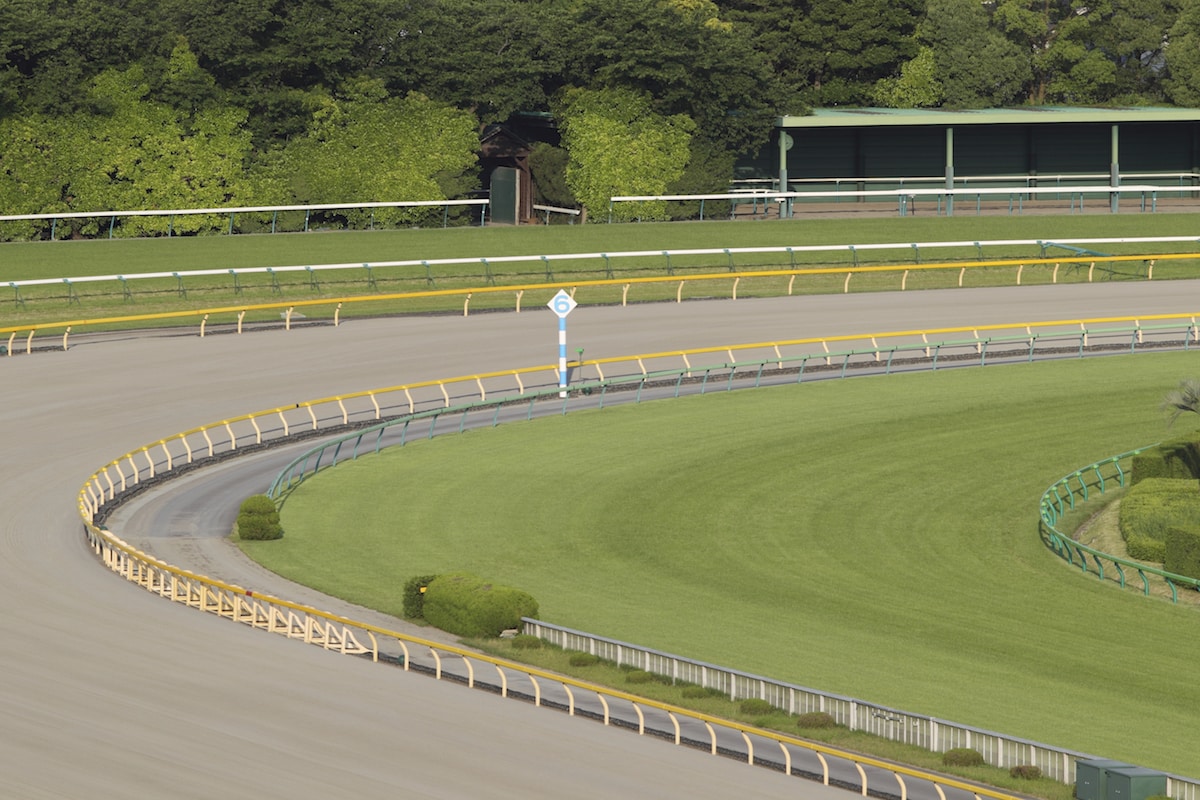Trainers consider footing preferences, pedigree and way of going when deciding which racing surface to run a horse on.

Most American racetracks have both dirt and grass surfaces, with the dirt track enclosing the turf one. Photo istock.com
Most major racetracks have both dirt and grass surfaces. Whether your former racehorse preferred grass over dirt likely depended on a variety of factors, from his pedigree to his conformation or even his disposition.
Originally, U.S. tracks only had dirt ovals, as many smaller tracks do today, whereas in Europe turf racing has always dominated. Midway through the last century, turf started becoming popular at American tracks, often installed within the area the dirt track encloses. Santa Anita in Southern California is one exception, as it has not only the inner turf track but also a hillside extension that allows for unique downhill racing.
Part of a racehorse trainer’s job is to analyze whether a horse is better suited for the dirt or the turf. Graham Motion has trained a variety of both types. Growing up in England, his first experiences were with turf horses. Today he bases his operation at Fair Hill Training Center, in Elkton, Maryland, a gorgeous facility with dirt, turf, and synthetic surfaces, as well as cross-country terrain.
Motion has succeeded with horses on all surfaces. He trained Animal Kingdom to win the 2011 Kentucky Derby on dirt and the 2013 Dubai World Cup on synthetic, run second in the 2012 Breeders’ Cup Mile on turf and earn more than $8 million over his racing career.
He’s had three Breeders’ Cup victories as a trainer, all of which have come on the turf.
Motion also trained Icabad Crane, who finished third in the 2008 Preakness Stakes and retired with earnings of $585,980. Icabad Crane won the 2014 Retired Racehorse Project America’s Most Wanted Thoroughbred title and is now an eventer.
“As a trainer, you get to see the horses train on both surfaces, and some of them just handle turf better,” says Motion. “A lot of it could be due to their action, the way they get across the ground, and the size of their feet.”
Motion has found that smooth, long action helps a horse perform well on a grass surface. He points to one of his trainees, Better Talk Now, who won the 2004 Breeders’ Cup Turf and earned more than $4 million, racing almost exclusively on the turf.
“He looked like a cross-country runner,” says Motion. “He was very athletic and didn’t carry a lot of flesh. He had an extraordinary action and way of getting across the grass.”
Some trainers believe that a horse with a larger foot — sometimes called a grass foot — is helpful. While Motion sees some validity in that, he doesn’t believe it’s the determining factor.
“Pedigree is probably 80-90% of it,” he says. “When you’ve got a European family, certainly some of them will handle the dirt. But more often than not, they will prefer the grass.”
That can be a self-fulfilling prophecy. If a stallion performs well on the grass as a racehorse, breeders might view him as a “turf sire” and send mares to him that could enhance that as they strive to breed a horse that runs well on the surface.
Most of the richest races in the United States are on dirt, including all of the Triple Crown events, major futurities for 2-year-olds and many of the big races for older horses, including the $6-million Breeders’ Cup Classic. Breeders, especially those who sell at auction, prefer stallions that can sire either dirt or turf horses.
“Really good horses run on anything,” says Motion, citing Animal Kingdom’s versatility.
Motion explained that while trainers tend to push a horse with a turf pedigree toward grass racing, they give horses the opportunity to show what they can do on both surfaces.
Sometimes the limitations are more related to distance ability. Racetracks conduct short and long races on both surfaces, but the longer races tend to be over the turf.
Every year, for instance, Santa Anita showcases long-distance turf racing in the San Juan Capistrano Handicap at about 1 3⁄4 miles. The race starts at the top of the downhill turf course, crosses the dirt to the main turf course, and then loops around that oval completely. At the old Arlington Park in Chicago, now closed and demolished, the major race every summer was the Arlington Million on the turf at 1 1⁄4 miles, the same distance as the Kentucky Derby.
Another factor that determines whether a horse prefers turf racing is how he handles the kickback on a dirt surface. At racing speed, horses’ hooves can send dirt into the air, which sometimes hits horses running behind the leaders. Turf racing minimizes that situation.
“I like starting a horse’s career on the grass,” says Motion. “It’s a little easier for them, and they don’t get that kickback. That can be really shocking for a 2-year-old if they’re not used to it.”
In 2016, Motion started the 2-year-old filly Dancing Rags on the turf because he felt the surface would be easier for her as an unraced horse. She finished third and then won her first race on the dirt, followed by a victory in the $400,000 Darley Alcibiades Stakes at Keeneland Race Course, in Lexington, Kentucky, also on the dirt.
Turf courses can get heavy and deep after a major rain. Motion says that sometimes horses’ turf ability depends on whether they can handle the deep going. Many times a horse that doesn’t perform well on the turf in Europe, where it rains often, does better on American grass surfaces, particularly in California, where it seldom rains.
Sometimes horses simply handle the design of American turf courses better than European ones. Main Sequence began his career in Europe without winning top races there. Motion trained him in this country to win the 2014 Breeders’ Cup Turf and several other big races.
Motion says he doesn’t train horses differently for turf or dirt. Trainers might work sprinters faster at shorter distances, regardless of surface, and put longer gallops into horses that prefer marathons.
“If you’re worried that a horse may not be quite fit enough, you can get away with a little bit more on the grass,” says Motion. “In the U.S., where the turf tends to be very firm and fast, it’s not as tiring as a deep dirt track.”
Turf racing might lengthen a horse’s racing career because it is easier on legs, feet, and joints. Pedigrees impact that, as well, because many turf horses descend from horses that mature later and do better over longer distances. Sprinters bred to run short distances on the dirt are traveling faster and, thus, hitting the ground harder, which is more conducive to injuries.
Motion, who is a proponent of finding horses good second careers after they finish racing, says turf horses transition to those careers every bit as successfully as dirt horses. The sport of steeplechasing is heavily populated with horses that began flat racing on turf tracks and then segued to turf racing over jumps.
He’s currently transitioning several horses to second careers. Howe Great, a graded-stakes winner and earner of $573,953 who got his start with Motion, for instance, recently entered the eventing world.
Sometimes successful racing on the turf boils down to the same factors that help a racehorse do well on dirt or an off-track Thoroughbred succeed in a second career. A sound, athletic animal with a good mind in the hands of a top trainer has the best chance of winning.

